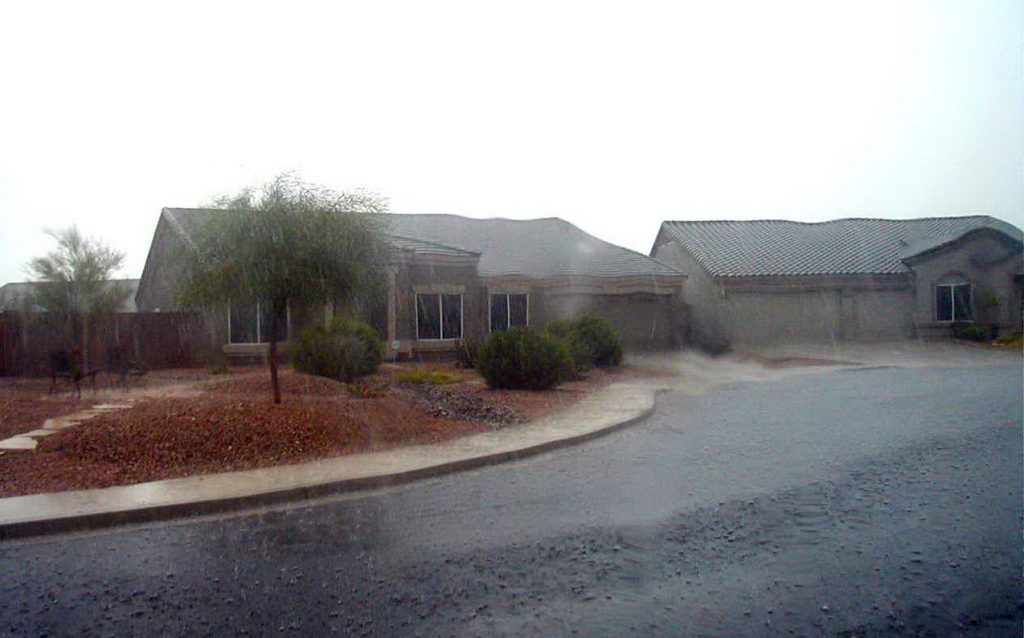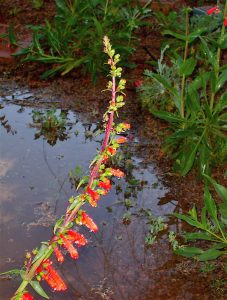July is not only Smart Irrigation Month, but it’s also our summer monsoon season. There’s no better time to talk about rainwater harvesting. Here are our best reasons to take advantage of this great resource.
1. Rain is free
Wouldn’t it be great if water just fell out of the sky? Okay, I’m kidding… it’s hard to imagine that right now… our 125th day without rain (our last significant rain was March 1). While we are well below normal in our rainfall so far this year, we do average almost 8-inches a year. And with a typical Arizona desert home, we have rooftops, driveways and sidewalks that make prime catchment areas. In fact, the rooftop of a 1500 square-foot home can collect almost 500 gallons from ½-inch of rain! Direct that to your plants and get a free watering of your landscape.
2. It’s good for your plants
Have you ever noticed how plants appear greener and brighter after a good rain? It’s not just because the dust and dirt get washed off. Rainwater is a clean, salt-free source of water that contains many beneficial ingredients for plants. Rain can contain sulfur, potash, several other minerals and even microorganisms, all of which provide a boost to plant growth. During summer thundershowers there can even be an added bonus when lightening converts atmospheric nitrogen into a nitrogen solution for plants. Free fertilizer, too!
3. You can help replenish groundwater
Typically, rain falls and seeps underground to become groundwater in aquifers and/or it feeds rivers or lakes. However, the concrete, asphalt and land grading of cities have disrupted this cycle. An ASU study showed that 60% of Tempe north of U.S. Highway 60 is impervious to water. What an even more compelling reason to collect as much rainwater as we can in our landscapes whether at our homes properties, businesses or along our city streets.
4. It will improve your soil and the environment
Rain is naturally distilled through evaporation prior to cloud formation making it one of the purest sources of water. This means that it’s one of the best ways to dilute salt buildup that naturally occurs in our soils. In arid areas like ours, salty soils occur because we have so little rainfall. Salt also builds up in our soils as we add our ‘hard’ water to the landscape with each irrigation. It is even recommended to run your irrigation an extra cycle or two in the summer to help wash excess salts past the root zone of plants where it can cause leaf burn and other plant problems. However, if we get a good monsoon and you are collecting rainwater on your landscape, these extra irrigation cycles will not be necessary. And, there’s yet one more benefit to mention. If you recently applied fertilizer, insect granules or sprayed weeds, it’s damaging to the environment to have those materials washed off your property and into our rivers. By harvesting rainwater, potential pollutants stay on your property.
5. Gravity is always there to help
Water harvesting is the term used to describe how rainwater is collected and channeled. Start from your highest water catchment surfaces (i.e. rooftop) and allow gravity to carry the water through gutters or channels to where you want it to provide the greatest benefit. Water harvesting systems can range from simple to complex. In a simple (passive) system the rainwater is directed right to the plants to be used immediately. A more sophisticated (active) system may include cisterns (a water storage tank), pumps and a delivery system. Designing water harvesting during new construction allows you to be more elaborate. Go outside during your next rainstorm (if there’s no lightening) and observe how the water flows off your structures and property. Then look for the valuable books on Rainwater Harvesting by Tucson author Brad Lancaster or check out these great University of Arizona references below to learn more about how to implement water harvesting techniques at your home:
- Harvesting Rainwater for Landscape Use
- Using Rainwater in Urban Landscapes: Quick Guide for Maricopa County
- Passive Water Harvesting – Rainwater Collection
- Basic Components of a Rainwater Storage System
- When It Rains It Runs Off: Runoff and Urbanized Areas in Arizona



